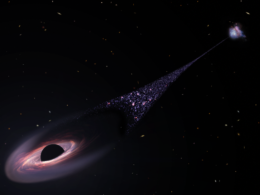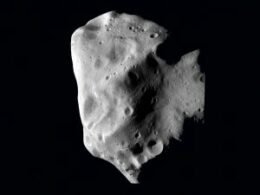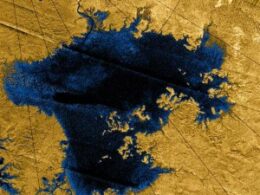Posted on July 18th, 2010
A bright display of natural “space clouds” is predicted to shine down over the UK, Ireland and similar mid-northern latitudes tomorrow night, Monday 19 July.

The shimmering phenomenon at the upper edge of the atmosphere, called noctilucent clouds, is only seen in mid-summer and from similarly placed locations – the sky does not get dark enough further north.
Why the clouds form is still much of a mystery. But they come out long after the sun has set and when normal, much lower clouds appear dark against the sky. They seem to be more common in years when activity on the sun is at a low level – and we are currently around the minimum phase in the 11-year solar cycle right now.
Some dazzling noctilucent cloud displays were put on last year and again earlier this month.
For the first time, a prediction of this natural light-show has been made by an amateur stargazer, backed by professional scientists. John Rowlands, one of four finalists for BBC Radio 4′s “So You Want to be a Scientist?” competition, forecasts a wave of the clouds for five nights from tonight (Mon).
He is backed by his mentor Professor Nick Mitchell, Director of Centre for Space Atmospheric and Oceanic Science at the University of Bath. They want people to look up if the sky is clear to check their predictions.
John, 41, an aerial photographer, of Anglesey, North Wales, said: “Go outside at around 11pm and look towards the north or north-east. As the Sun gets lower and lower below the horizon, the noctilucent clouds will get brighter and brighter.”
John’s prediction comes after studying weeks of satellite data plus radar observations from Sweden and previous observations of noctilucent clouds. He has set up a Facebook page so that people can follow and contribute to the experiments.
John has found that the clouds seem to form at a height of around 60 miles when the upper region of the atmosphere, called the mesosphere is at its coolest. The data suggests it will be at this stage tomorrow (Mon).
Professor Mitchell said: “We hope to do some useful and interesting science, but we also want to draw attention to noctilucent clouds as a beautiful and mysterious phenomenon of the summer night sky that many people don’t know about.”
Oddly, some scientists believe a brilliant showing of noctilucent clouds in 1908 was triggered by the explosion of an incoming asteroid or comet over Siberia in the famous Tunguska event.
• Discover space for yourself and do fun science with a telescope. Here is Skymania’s advice on how to choose a telescope. We also have a guide to the different types of telescope available. Check out our monthly sky guide too!




